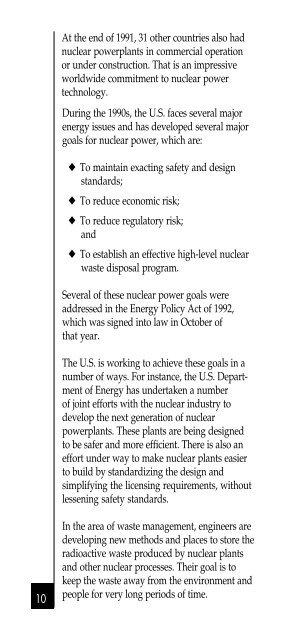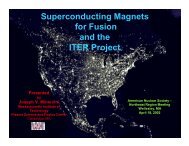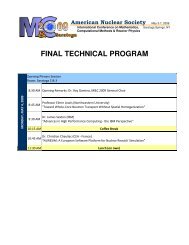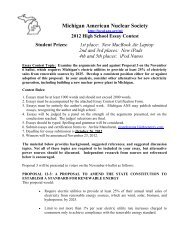DOE-NE-0088
DOE-NE-0088
DOE-NE-0088
You also want an ePaper? Increase the reach of your titles
YUMPU automatically turns print PDFs into web optimized ePapers that Google loves.
At the end of 1991, 31 other countries also had<br />
nuclear powerplants in commercial operation<br />
or under construction. That is an impressive<br />
worldwide commitment to nuclear power<br />
technology.<br />
During the 1990s, the U.S. faces several major<br />
energy issues and has developed several major<br />
goals for nuclear power, which are:<br />
◆ To maintain exacting safety and design<br />
standards;<br />
◆ To reduce economic risk;<br />
◆ To reduce regulatory risk;<br />
and<br />
◆ To establish an effective high-level nuclear<br />
waste disposal program.<br />
Several of these nuclear power goals were<br />
addressed in the Energy Policy Act of 1992,<br />
which was signed into law in October of<br />
that year.<br />
The U.S. is working to achieve these goals in a<br />
number of ways. For instance, the U.S. Department<br />
of Energy has undertaken a number<br />
of joint efforts with the nuclear industry to<br />
develop the next generation of nuclear<br />
powerplants. These plants are being designed<br />
to be safer and more efficient. There is also an<br />
effort under way to make nuclear plants easier<br />
to build by standardizing the design and<br />
simplifying the licensing requirements, without<br />
lessening safety standards.<br />
10<br />
In the area of waste management, engineers are<br />
developing new methods and places to store the<br />
radioactive waste produced by nuclear plants<br />
and other nuclear processes. Their goal is to<br />
keep the waste away from the environment and<br />
people for very long periods of<br />
20<br />
time.
















